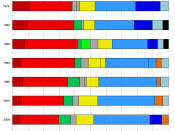Topic: The subsidiarity principal in the European UnionContent:1.Introduction2.The origins and first manifestations of the principal of subsidiarity in the EC3.The subsidiarity principle itself- The Treaties of Maastricht and Amsterdam4.Case law and the European Court of Justice4.1.The Tobacco Advertising Case4.2.The Working Time Directive5.Evolution of the Principle in recent years- From Amsterdam until today6.Conclusion1.IntroductionSubsidiarity can be defined as:"the principle that a central authority should have a subsidiary function, performing only those tasks which cannot be performed effectively at a more immediate or local level."Within the European Union, it is the fundamental principle for defining the border line between EU and member state responsibilities. The principle is incorporated in the treaty of Maastricht, signed on 7 February 1992, among other guidelines that discipline the different profiles of the European integration process.
However, the concept is by far not an invention of the EU, but has a long tradition and experienced an evolution which was to a large extent parallel to the evolution of political sciences.
The word subsidiarity is derived from the Latin term subsidiarius and has its origins in Catholic social teaching. It mainly claims that government should carry out only those activities which exceed the capacity of individuals or private groups acting separately. The autonomy and dignity of the human individual is thus the central value of the principle, wherefore all other forms of society (e.g. family, state, international order) should be in the service of the human being. Without going further into detail, it seems appropriate to mention that it was elaborated in the encyclical Rerum Novarum of 1891 by Pope Leo XIII, as an attempt to articulate an intermediate option between capitalism on the one hand and the different forms of communism, which are characterized by the subordination of the person to the state, on the other.
This case work will focus on the principle of subsidiarity, which also influenced significantly the distribution of competences in federal and regional states and underwent a continuous empowerment within the European integration process in the last decades.
The achievements federal states obtained in this matter did often inspire the European Union. The drafting of Article 5 (ex 3b), in which the subsidiarity concept is contained, is definitely influenced by the German law concerning the relationship between Bund and Länder.
At the very beginning there will be an analysis of the first concrete manifestations of a progressively increasing absorption of the principle into the communitarian activity before the treaty of Maastricht. In this regard, it is interesting to see that, although not explicitly embraced by legal documents, this principle de facto influenced the construction of the European community from its foundation onwards.
In the second part, the principle as it is incorporated in the EC today will be analyzed in detail and problematic aspects of it will be outlined. The chronological framework taken into account in this section will go from the EC Treaty to the constitutional treaty (excluded).
The third part will be a practical investigation on two law cases in which subsidiarity related topics played a significant role. In detail the 'Tobacco advertising' case and the 'Working time directive' case will be examined.
To carry on the theoretic-historical discourse started in the first and second section, in part three the ultimate developments regarding subsidiarity, which are included in the constitutional treaty and would largely answer various problems, will be outlined.
The Conclusion will give place to brief summary of the casework and a subsequent reflection on the principle of subsidiarity.
2.The origins and first manifestations of the principal of subsidiarity in the ECThe most significant legal steps regarding the subsidiarity principle were taken through the treaty of Maastricht and the Protocol on the Application of the Principle of Subsidiarity and proportionality as we will see later on.
However, also in the decades before 1992, the principle influenced to a large extent the evolution of the European Communities.
As P. De Pasquale lines out, there had been an increasingly frequent recourse to Article 235 of the EC treaty (later on art. 308 EC), which enhances the competences of the Community for the purpose of crating a common market . The Community exercised its power in fields that where not explicitly listed in any Treaty, but which it identified as "sensible" sectors (e.g. monetary policy). This ambiguous development alarmed the Member States that subsequently pointed out the principle of subsidiarity, as they wanted to secure their protagonist role within the process of European integration.
The first functional achievements for the Member States took place at the beginnings of the 70s with the so called Tindeman report. In this report of the Commission on the European Union (5/1975) the principle is explicitly mentioned. It contains the idea that the objective of the Community should not be becoming a centralized "super-state", but rather should concentrate on attributing more powers to regional and national institutions.
A second weighty step was taken through a draft resolution (Draft Treaty Establishing the European Union) written by A. Spinelli, adopted by the European Parliament in 1984. Again, it was affirmed that the Union should be regarded as a proper juridical person whose competences should be individuated according to the subsidiarity principle. There had been a clear definition of the competences of the Union, and possible invasions in matters regarding national competences were disciplined.
Furthermore, the Single European Act (1987) gave attention to the principle, although not regarding the community legislation as a whole. In concentrates, in fact, on integrating effectively subsidiarity into the field of environmental politics. However, it became an important prototype from which the EU and its member states derived the regulation of competences in other fields, as the one of research and technological development as well as economics and social cohesion.
To sum up, there were initiatives in favor of the enhancement of the regarding principle long before 1992. But surely the most relevant definition of subsidiarity within the European Union is included in the Treaty of Maastricht up to this day, wherefore we will examine the relevant article in the next paragraph.
3.The subsidiarity principle itself- The Treaties of Maastricht and AmsterdamIt is the main purpose of this paper to understand how the subsidiarity principle is applied to the relations between the EU and the Member states, and thus when concretely legislation is adopted by Member states, unless there is a good reason for adopting it at community level.
The 'S' concept was unquestionable one of the main topics discussed during the Maastricht negotiations and was the main instrument the Member States brought into play in order to argument against the federalist propensity of the Community under the TEU.
The intention to "regulate the lawfulness of the exercise of Community competences" was surely elevated, but the result achieved in Maastricht is satisfactory only up to a certain point as we will see. Article 2 of the TEU says that any action taken by the Union to achieve its objects must meet the terms of the principle of subsidiarity. In Article 5 of the EC Treaty, a definition of subsidiarity and proportionality is given:The Community shall act within the limits of the powers conferred upon it by this Treaty and of the objectives assigned to it therein.
In areas which do not fall within its exclusive competence, the Community shall take action, in accordance with the principle of subsidiarity, only if and in so far as the objectives of the proposed action cannot be sufficiently achieved by the Member States and can therefore, by reason of the scale or effects of the proposed action, be better achieved by the Community.
Any action by the Community shall not go beyond what is necessary to achieve the objectives of this Treaty.
In the first the paragraph, we find the so called principle of limited powers, which requires the Community to keep within its limits. This concept has been regulated by the European Court of Justice through art. 308 (ex. Art. 235) as well as through the recognition of the implied- powers doctrine. The Communities legislative competences have undergone a continuous evolution, similar to the one of subsidiarity, and were increasingly defined the SEA, TEU and the ToA.
The second paragraph is the most crucial one for this analysis, as it deals with subsidiarity. It is of course closely linked to the third paragraph, which says that the Community must not go beyond what is necessary to realize the purposes of the Treaty. This is the proportionality principle, strongly present in the German law under the name 'Verhältnissmässigkeit'.
Looking closer at the second paragraph, however, reveals that the legal consequences of the Article are restricted. First of all, because it takes into account only the exercise of powers, irrespectively of whether the powers are actually granted to the Community by a Treaty or not.
Furthermore, it is limited to the fields that do not fall into the "exclusive competences" of the Community, which yet are not defined in the Article. Following the interpretation of the Commissions, 'exclusive competence' is present whenever "Treaties impose [on the Community] a duty to act" . According to the Commission, these areas are: the removal of barriers to the free movement of goods, persons, services and capital; the common commercial policy; the general rules on competition of fisheries resources; and the essential elements of transport policy.
Subsequently, the areas in which the Community and Member Sates share jurisdiction, and thus areas in which the subsidiarity principle might apply, are limited from the very beginning by an ambiguous constraint.
The second crucial document is the Protocol on the Application of the Principles of Subsidiarity and Proportionality annexed to the EC Treaty by the Treaty of Amsterdam. Thus, Protocol sets precise criteria for applying these principles. Paragraphs four and five declare that the Community has to provide justification for legislating in terms of the subsidiarity- and the proportionality principle. Justification is only given if two 'necessity tests' and one 'clear benefit test' are satisfied. The first two imply that the question has trans-national aspects that cannot be satisfactorily regulated by national measures and that national measures alone would conflict with the requirements of the EC Treaty and thus Member State's welfare. The third test, in other words, requires that action at Community level provides clear advantages compared to state measures.
Paragraph 9 of the Protocol furthermore requests the Community to submit an annual report on the Application of Article 5 and to give preference to framework directives over regulations (paragraph 6). Although this document surely defines better the discussed concept, it does not solve the problem of the 'exclusive competences' and thus "does not call into question the powers conferred on the EC, as interpreted by the ECJ" .
Regarding the difficulty of the definition of exclusive competences, Craig and De Burca point out two main interpretations. The first is given by A. G. Toth, who identifies the exclusive competences as those areas in which the "Member States have transferred power to the Community, irrespectively of whether the Commuinty actually exercised this power" . The regarding areas would obviously be all topics covered by the original EEC Treaty (listed above). The second point of view, which of course challenges the first one, is given by J. Steiner, who writes: "[â¦] the only areas in which the Community has exclusive competence for the purpose of Article 3b are those in which it has already legislated [â¦]" .
So Steiner claims that the 'S' principle is only invalid when the Community de facto has already exercised its power.
As there are no clear guidelines until today, the scope and nature of Community legislation will probably experience further clarifications, in which the subsidiarity principle will play a significant role. Before continuing a reflection on the possible future developments, the next section will focus on case law related to our topic.
4.Case law and the European Court of JusticeThe Court could play a significant role in providing a judicial interpretation of Article 5 (ex Article 3b) and clarifying the grey areas outlined in the previous paragraph. The judicial review process of the ECJ is however limited in this subject. Until this day, there are no cases in which the Court has struck down legislation applying Art. 5 (2nd paragraph).
This does not imply in any case that the subsidiarity principle would not influence jurisdiction of the ECJ. The following cases will show in how far the principle had an effect on adjudication.
4.1.Germany vs. European Parliament and Council (Case C-376/98)This case, identified as the Tobacco Advertising case of 1998, is one example in which the Court of Justice of the European Communities struck down a whole EU directive (98/43) due to "the idea behind subsidiarity" .
The directive prohibited every form of advertising and funding of tobacco products throughout the Community. Already in 1989 a directive (89/552) was introduced that regulated a similar issue, namely it banned tobacco advertising in television, and was not affected of the new one. The reason behind it was that otherwise the free movement of services, that's to say television broadcasting, would be distorted when some states forbid it and others did not.
As the 3rd paragraph of the judgment states, the directive:"[â¦] was adopted on the basis of Article 57(2) of the EC Treaty (now, after amendment, Article 47(2) EC), Article 66 of the EC Treaty (now Article 55 EC) and Article 100a of the EC Treaty (now, after amendment, Article 95 EC)".
Art. 95 [100a] grants a power to adopt legislation needed for the establishment of the internal market. Art. 47(2) [57(2)] and 55 [66] EC instead concede power to adopt legislation to make it easier to take up an activity as a self-employed person, or to provide and receive service, in other member States.
Exactly here the main problem we discussed on a theoretical basis in part 3 arises. Germany, in fact, claimed that no treaty provision gave the Community the required power to put forward this directive and underlined in this regard the principle of subsidiarity.
The complainant argued that the directive regulated a public health issue, which of course would not make part of the "exclusive competences" of the Community. The latter one instead argued that it was promoting the free movement of goods (e.g. newspapers) or services and the fair competition and thus had the right to harmonize the Member State law in this sphere. Germany also emphasized the fact that national legislation would more efficient and that the argument of the defender was senseless, as tobacco advertising in newspapers affected only the countrywide press and not imports. This was approved by the ECJ in paragraphs 97-99 of the judgment. Furthermore, the Court explains in paragraph 115: "In view of all the foregoing considerations, a measure such as the directive cannot be adopted on the basis of Articles 100a, 57(2) and 66 of the Treaty" . Subsequently, the European Court of Justice annulled the directive entirely.
As we see, however, the Court did not apply the principle of subsidiarity, but the principle of limited powers or "ultra vires" in English legal jargon. The ECJ agreed to the fact that the Community invaded the sphere of Member States and that there was no good reason for the Community to act instead of the states themselves. This case nevertheless also reveals that action taken at a national level is not always unquestionably desirable. Nations often might be more influenced by proper economic-political aims than a supranational organization as the EU. From the point of view of social wellbeing for instance, an increase in welfare might be achieved if the relevant profits would be invested in other things than tobacco advertising.
4.2.Working time directiveIn 1993, the Council adopted directive 93/104, which concerned certain aspects of the organization of working time. The directive was adopted on the basis of Article 118a (now 138) which provides as follows:"1. Member States shall pay particular attention to encouraging improvements, especially in the working environment, as regards the health and safety of workers, and shall set as their objective the harmonization of conditions in this area, while maintaining the improvements made.
2. In order to help achieve the objective laid down in the first paragraph, the Council, acting in accordance with the procedure referred to in Article 189c and after consulting the Economic and Social Committee, shall adopt by means of directives minimum requirements for gradual implementation, having regard to the conditions and technical rules obtaining in each of the Member States. Such directives shall avoid imposing administrative, financial and legal constraints [â¦]."Thus, the directive lays down minimum health and safety requirement for the organization of working time and Art.118 a gives the Council the legal power to adopt directives in this field.
The United Kingdom and the Netherlands took court action and argued that the directive constituted an infringement of the principle of subsidiarity as there were no clear benefits derived from the action taken at Community level.
In the judgment of European Court of Justice, the latter opposes to the applicants motion vigorously. It outlined that it was the Council's responsibility, under Article 118a, to adopt minimum requirements so as to contribute to the improvement of health and safety of workers. Community-wide action was thus required according to the Court, wherefore the Council legally harmonized the minimum standards. With reference to the non-compliance of the subsidiarity principle, the Court clearly states that the applicants' argument can be rejected at the outset . That is due to the interpretation of the Article 118a, according to which Community action was undeniably needed. There was only one sentence, namely the second sentence of Article 5, which the ECJ annulled. This sentence required a minimum rest period that must, in principle, include Sunday. According to the judgment, this provision in fact did not directly contribute to the improvement of health and safety protection of workers.
To sum up, the success of the subsidiarity principle in this case was much poorer than in the tobacco advertising case analyzed before. For our purpose, it would not make much sense to have a look at further cases, as all of them would reveal the same result: the ECJ seemingly will not without due consideration overturn Community action on the ground of that it does not comply with Article 5.
5.Evolution of the Principle in recent years- From Amsterdam until todayThe already outlined shortcomings of Article 5, EC Treaty, have not been unobserved by the Community. The Committee of Regions (CoR), established in 1994 under the Treaty on European Union (Maastricht), continuously emphasized the weaknesses of subsidiarity within the EU and demanded for clearer definitions for the purpose of increasing the participation of European regions in community life.
The Laeken Declaration of December 2001 drew attention to the problematic points underlined by the CoR. A new framework for the principles of subsidiarity and proportionality were designed and the draft Treaty establishing a Constitution for Europe contained a new definition of both. It explicitly recognized the local and regional dimension in defining the principles. The CoR, above all the working group on subsidiarity, participated actively in the work of the European convention, which sketched out "new prospects for implementation and monitoring of subsidiarity at Community level" . The Protocol on the Application of the principles of subsidiarity and proportionality, annexed to the new Treaty, had been revised. It includes the CoR as integral part of the EU organism as regards the application of the discussed principle.
The draft constitution itself includes a specific definition of subsidiarity (Fundamental Principles and Article 1-12), and classifies the exclusive (Article 1-13) as well as the shared competences (Article 1-14) of the Union and its twenty-seven member states. Due to the referenda on the Constitution in France in the Netherlands, the draft constitution never entered into force and is questionable when the new achievements will be legally positioned in a new Treaty.
However, it is quite likely that the format of the Protocol will be adopted with the coming into force of a new Treaty. Should it not come into force, subsidiarity monitoring per se will not be affected, as it is already a fundamental part of good governance under the exiting EU law, as we saw before. But within the EU legislative process, the revised subsidiarity protocol provides for an enhancement of the sub-national levels' role, which would not come into existence without any new Treaty.
The legislative process is divided into two key-phases, namely the pre-legislative- and the legislative phase. In both, the principles of subsidiarity and proportionality can be applied. Concerning the pre-legislative phase, already in the treaty of Amsterdam aspects as i.e. the assessment criteria for compliance with the subsidiarity principle and the financial impact for local and regional authorities, were present. But Article 2 of the new Protocol annexed to the Constitutional Treaty for the first time explicitly introduces regional dimension of consultation for ensuring appropriate discussion before proposing major policy initiatives. In fact, the Article states: "Before proposing European legislative acts, the Commission shall consult widely. Such consultations shall, where appropriate, take into account the regional and local dimension of the action envisaged."With respect to the legislative phase, the Committee of Regions at the moment has the right to express its opinions and positions concerning the compatibility of any pre-legislative or legislative proposal with the subsidiarity and proportionality principles. The Constitutional treaty would introduce an important innovation in this regard, namely the so called 'early warning mechanism'. Within the process of monitoring subsidiarity, national parliaments could thereby take a direct part in the legislative process, benefiting from a direct relationship with Community institutions. Also the Committee of Regions can participate in this key phase of supervising subsidiarity, although it is not explicitly mentioned. The Treaty outlines that in areas as e.g. culture, economic and social cohesion, education and youth etc. the CoRs competences would come into play.
Finally, the Constitutional Treaty modified also aspects of the ex-post judicial review. The annexed Protocol on Subsidiarity, gives the right of instituting proceedings also to national parliaments of member states and the Committee of Regions (before only institutions of the EU had this right). It is needless to say, that this advance would be meaningful, as the Committee would receive the right to challenge the legality of Community law and thus legally combat for the annulment of certain directives or regulations. The CoR would thus have the right to refer a matter to the European Court of Justice whenever: 1. the committee has not been consulted also on a matter on which it should have been consulted (up to this day, this right is given only to EU institutions); 2. The committee wants the EJC to check the compliance with the 'S' concept in matters in which it has the right to be consulted.
All in all, the Committee of Regions would become an important actor in the monitoring of the principles and a real guardian of subsidiarity.
6.ConclusionThis case work tried to outline the most relevant features of the role of the principles of subsidiarity and proportionality within the European Union. Both, as we saw, are closely linked to each other and aspects of the first are included in the second one. If for instance community legislation infringes the principle of proportionality, it will violate also the principle of subsidiarity. If the first one is better defined, the second one is likely to benefit from this.
In the fourth part of the work, two cases were examined and it was said, that after ten years of experience with the 'S' principle in the institutional life of the Community, the ECJ has built up only little case law in this subject. The validity of a piece of Community legislation was never neglected exclusively due to the violation of subsidiarity. The ECJ has often been criticized of applying Article 308 (ex Article 235) and Article 95 (ex Article 100a) too broadly and of not giving enough support to Article 5, especially the second paragraph.
However, as P. Craig and C. De Burca rightly point out, it should be taken into account that "the greatest expansion of Community competence has been through successive treaty revision" . So Member States themselves allowed the Community to take over certain competences in defined fields and were willing to transfer their power. The problem is mainly that mostly limited powers are transferred, which makes the whole debate so complex. If the Union and the Member Sates would be able to reduce the so called "shared competence", problems might be reduced.
In the last part of the case work, special attention was given to the ultimate evolution of subsidiarity within the European Union. The new protocol on subsidiarity appended to the Constitutional Treaty, includes terms that are much severer than the current ones with respect to the justification of legislative proposals. This might make it easier to the ECJ to review Community directives or regulations. The current reluctance of the European Court of Justice might in fact be justified by the fact that the subsidiarity principle has not lent itself ready to judicial review.
To predict the future evolution of subsidiarity with the European integration process is of course difficult. Nonetheless, in order to conclude, the following ideas should be mentioned: the principle of subsidiarity was, is and will always remain an important instrument for merging the interests of the citizens with those of the EU. It is not anymore a purely functional concept that should regulate the economic interaction between Member States and the Community. Subsidiarity in the EU has also a social-political dimension, insofar as it guaranties to the citizens of the EU a democratic sphere in which they can continue developing their national, regional or local identities. If we assume that the Constitution Treaty has disregarded by the citizens of the Community due to the fact that they fear a Community that is increasingly characterized by "top-down" actions, the enhancement of Article 5 of the EC Treaty might be an efficient way of counteracting this trend. In order to solve the antagonism between European integration, which however remains the key aim of the Community, and the maintenance of national and regional authority methodical aspects of the Community should be improved. Almost no one is against the European integration, but against the way the Community legislates. Subsidiarity could also in the future be a significant methodical tool for enforcing multilevel based governance within the EU.
On the other hand, it is not even worthless taking federal states and their evolution as a point of reference for predicting future European developments. The history of federal States within Europe, as for instance Germany, shows that regions gradually transferred more and more of their power to the state. With the passing of time, areas of competence were clearly defined so that tensional between the sub-national and the national level diminished.
According to me, the European Union is already and is likely to continue experiencing a similar legal development as national states did time ago. The European integration process is taking place that around 50 years, and desirable aims are collectively followed, but the cooperation between members and EU still has to be improved, and I think that it will be interesting to observe the role of subsidiarity within this process.
Bibliography:Books:â¢Craig, Paul P.; De Búrca, Gráinne: EU law: text, cases, and materials, Oxford Univ. Press , 2007â¢Hartley, Trevor C.: European Union law in a global context: text, cases and materials, Cambridge Univ. Press, 2005â¢Patrizia De Pasquale, Il principio di sussidiarietà nella Comunità Europea, 2000, Editoriale Scientifica, Napoli, 2000â¢Centre for Economic Policy Research, La distribuzione dei poteri nell'Unione Europea, Società Editrice il Mulino, Bologna, 1995â¢George A. Bermann, Subsidiarity: does it have a future? , Centro di studi e ricerche di diritto comparato e straniero, Roma, 1997Internet:â¢http://www.cor.europa.eu/subsidinet/en/sublibrary.htmâ¢http://eur-lex.europa.euâ¢http://subsidiarity.cor.europa.eu/â¢http://www.curia.europa.eu/Treaties and Protocols:â¢The Treaty on European Union and of the Treaty establishing the European Communityâ¢Treaty establishing a Constitution for Europeâ¢Protocol on the Application of the Principles of Subsidiarity and ProportionalityJudgments:â¢Judgment of the Court of 5 October 2000, Germany v European Commission and Council- Directive 98/43/EC concerning advertising and sponsorship of tobacco products. -Case C-376/98â¢Judgment of the Court of 12 November 1996. - United Kingdom of Great Britain and Northern Ireland v Council of the European Union. - Council Directive 93/104/EC concerning certain aspects of the organization of working time - Case C-84/94





